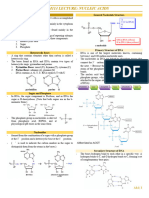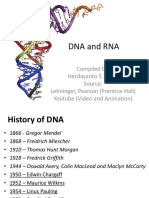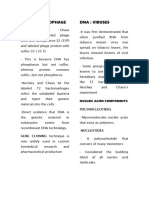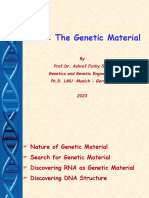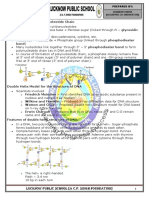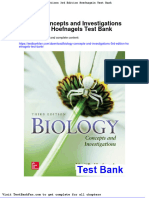Professional Documents
Culture Documents
DNA Synthesis and Sequence
Copyright
Available Formats
Share this document
Did you find this document useful?
Is this content inappropriate?
Report this DocumentCopyright:
Available Formats
DNA Synthesis and Sequence
Copyright:
Available Formats
Volume 6, Issue 7, July – 2021 International Journal of Innovative Science and Research Technology
ISSN No:-2456-2165
DNA Synthesis and Sequence
1: 2:
VIVEK SHUKLA MANOJ KUMAR
(Btech/Mtech Dual Degree 3rd Year Student atKIIT School (MSc Botany 1st year Student at Seth MotiLal College,
of Biotechnology(KSBT), KIIT University, Rajasthan)
Bhubaneswar, Odisha)
Abstract:- DNA(Deoxyribonucleic acid) is a chemical DNA molecule comprises of two poly nucleotide strands.
molecule which consists of all the necessary information • The bases are occupied the interior of the helix, the
that a living human being must possess. These sugar–phosphate chains are wrapped about its periphery,
instructions are then passed on from one generation to thus reducing the repulsions among charged phosphate
another. Our main objective via this article is to explain groups
how DNA can be obtained by many different techniques • DNA comprises of two long chains of simple units
and methods of analysis. DNA synthesis techniques are which are called nucleotides, with backbones made of
becoming a major part of modern day biology and plays base, sugars and phosphate groups.
a vital role in the field of synthetic biology. Through this • Each nucleotide is always attached via hydrogen bond to
review paper we will try to explore the various form specific complementary base pairing.
techniques that are widely used in the synthesis of DNA. • The aromatic bases have a vander Waals thickness of
We have also discussed the applications of DNA to gene 3.4Å and are always partially piled upon each other.
expression. We will also provide a brief introduction and • Sugar & Base is together called as nucleoside
discuss about DNA replication and what are processes • Phosphate, sugar & Base are collectively known as
responsible for DNA replication. nucleotide
• Adenine and Guanine are together known in a group as
I. INTRODUCTION – Purines
• Cytosine & Thymine are together known in a group as -
• Genes consists of DNA and re responsible for the source Pyrimidines.
of information to makemolecules called proteins.
• BASE PAIRING : Adenine pairs with Thymine with a
• In1868, Friedrich Miescher secluded a phosphorus-
double bond(A =T) in case of DNA whereas it pairs with
involving material. He discovered that the material
Uracil in case of RNA(A=U), Guanine pairs with
consisted of DNA, and a basic portion(protein). Kossel
Cytosinewith a triple bond(G≡C)
showed that DNA contains four nitrogenous bases A, C,
G, and T. • Major difference between DNA and RNA is the sugar,
• Levene later showed that DNA comprises of a huge with the 2-deoxyribose in DNA being substituted by the
quantity of reoccurring units called nucleotides; which different pentose sugar ribose in RNA.
consisted of a sugar, a phosphate, and a base. • DNA is a negatively charged molecule due to the
• He also incorrectly suggested that DNA comprises of a presence of phosphate group.
chain of four-nucleotide units, consisting of all the four
bases—―Adenine, Guanine, Cytosine, and Thymine”— DNA as the Genetic Material :-
in a fixed sequence(tetra nucleotide theory). The genetic material has four criteria.
1. Information: comprises of information essential to
construct an entire organism.(codingregions/genes)
2. Transmission: It is carried from parents to offspring
during the process of reproduction(vertical
transmission).
3. Replication: It must be copied(haploid to diploid).
4. Variation: The genetic material must differ in ways that
are responsible for the the known phenotypic differences
among all species(recombination).
Chargaff (late 1940s) –DNA molecules have distinctive
basecompositions:-
1. The base formation of DNA is generally different
among all genus.
2. DNA specimen extracted from different tissues of the
same species have similarcomposition.
3. The base composition of DNA in a given species
remains unaltered with an organism’s age, nutritional
state, or changing environment.
Figure-1: DETAILED ARRANGEMENT 4. Among all genus:
IJISRT21JUL329 www.ijisrt.com 159
Volume 6, Issue 7, July – 2021 International Journal of Innovative Science and Research Technology
ISSN No:-2456-2165
• The total purine residues = the total pyrimidine (i)less expensive(ii)accurate
residues
Chargaff base pairing rule: [Purines = Pyrimidines] Sanger methods:
(1) The double-stranded DNA (dsDNA) is reduced to two
Applies to ds DNA, important for maintaining a
single-stranded DNA(ssDNA).
stable DNA structure.
(2) A primer that harmonizes to one terminal end of the
sequence is joined.
II. DNA SEQUENCING
(3) Four polymerase solutions consist of four types of
dNTPs however only onetype of dNTP is added.
It is a method of establishing the nucleic acid
(4) The DNA synthesis reaction starts and the length
pattern– that is the arrangement of nucleotides in DNA. It
elongates unless any stopnucleotide is added casually
consists of any technique that can be taken into
(5) The consequential DNA portions are reduced into
consideration in order to predict the arrangement of the four
ssDNA.
bases: adenine, guanine, cytosine, and thymine.
(6) The reduced portions are discarded via the process of gel
electrophoresis andthe sequence is analysed.
Different technologies:-
Sanger sequencing.- is performed during low-
throughput, targeted, or short-read.
Capillary electrophoresis. Capillary electrophoresis
(CE) instruments are efficient in performing both Sanger
sequencing and fragment analysis.
Next-generation sequencing(NGS), they are vast-scale
techniques that enhance the velocity and lower the
expenditure.
DNA sequencing can establish a error-free diagnosis
influencing the medical administration of symptoms, or
supply treatment options.
Figure-3:- SANGER SEQUENCING METHODS AND
STEPS
Sanger sequencing provides high-value sequence for
approximately long stretches of DNA (up to about 900 base
pairs). It is mostly done to sequence separate pieces of
DNA, such as bacterial plasmids or DNA transcribed in
Polymerase Chain Reaction.
Capillary electrophoresis and fragment analysis:-
Capillary electrophoresis (CE) is an alternative to
conventional slab gel electrophoresis for the removal of
DNA portions. The bulk of DNA needed for separation is in
Figure-2:- STRUCTURE OF DNA & COMPLENTARY the nanogram range. Single-base resolution can be obtained
BASES on portions up to several hundred base pairs.
(i)SANGER SEQUENCING:-. Capillary electrophoresis is a method that removes
This method is established for predicting the pattern of ions based on their electrophoretic mobility with the
nucleotide bases in a portion of DNA.It was used in the application of an applied voltage. The electrophoretic
Human Genome Project to predict the pattern of small mobility is dependent upon the charge of the molecule, the
portions of human DNA. These fragments and constituted viscosity, and the atom's radius Capillary electrophoresis
larger DNA portions and, ultimately, entire chromosomes. (CE) is the most frequently used for separating and
The development of NGS technologies has exaggerated detecting short tandem repeat (STR) alleles in forensic DNA
genomics research.. Sanger sequencing remains widely used laboratories spread worldwide.
in the sequencing field as it offers several prominent
advantages:
IJISRT21JUL329 www.ijisrt.com 160
Volume 6, Issue 7, July – 2021 International Journal of Innovative Science and Research Technology
ISSN No:-2456-2165
Phosphoramidite-based synthesis of oligonucleotides.
This synthesis process is the most commonly used for the
synthesis of DNA oligonucleotides for gene synthesis.
The main difference between protein synthesis and
DNA replication is that the protein synthesis is the
formation of a functional protein molecule based on the
information in the genes whereas DNA replication is the
production of an exact replica of an existing DNA molecule.
The most important event occurring in S phase is the
replication of DNA. The aim of this process is to produce
double the amount of DNA, providing the basis for the
chromosome sets of the daughter cells
The raw materials for DNA synthesis are the
Figure-4:- CAPILLARY ELECTROPHORESIS nucleotides:-
deoxyadenosine triphosphate (dATP),
ii) Next-generation sequencing(NGS):- deoxythymidine triphosphate (dTTP),
Next generation sequencing (NGS), explains a DNA
deoxycytidine triphosphate (dCTP), and
sequencing technology which has modernised research in
genomics. The basic next-generation sequencing processes deoxyguanosine triphosphate (dGTP)—collectively
comprises of breaking up DNA or RNA in numerous referred to as deoxyribonucleoside
portions, inclusion of connectors, and reorganising. It is triphosphates (dNTPs) or deoxyribonucleotides
mostly identical to capillary electrophoresis.
Methods of Next-Generation Sequencing:-
1. Reversible Terminator Sequencing .
2. Single-Molecule Real-Time Sequencing
3. Ion Torrent
The new methods came to be known as next-
generation sequencing as they could formulate collateral
methods to develop high quantity of sequence from
numerous samples at very fast rate.
Advantages of NGS include:
Higher sensitivity to track and identify low-frequency
variants. Quick replication time for high sample volumes.
High genome analysis in details.
III. DNA SYNTHESIS
DNA synthesis is a biological process by which a Figure-5:- DNA REPLICATION DIAGRAM
DNA molecule is formed. In the cell, each of the two strands
of the DNA molecule acts as a template for the synthesis of IV. DNA REPLICATION
a complementary strand. DNA biosynthesis happens when
a cell divides, in a process called replication. It comprises DNA replication is the biological process of forming
of separation of the DNA double helix and thereafter two similar replicas of DNA from one original DNA
synthesis of complementary DNA strand, using the parent molecule. DNA replication happens in all living organisms
DNA chain as a template. The other strand (lagging strand) acting as the mostnecessary part for biological legacy..
also has to be produced in segments (Okasaki fragments)
The purpose of DNA replication is to produce two
Oligos are synthesized from building blocks which identical copies of a DNA molecule. This is essential for cell
replicate natural bases. The process has been automated division during growth or repair of damaged tissues. DNA
since the late 1970s and can be used to form desired genetic replication ensures that each new cell receives its own copy
sequences as well as for other uses in medicine and of the DNA.
molecular biology.
IJISRT21JUL329 www.ijisrt.com 161
Volume 6, Issue 7, July – 2021 International Journal of Innovative Science and Research Technology
ISSN No:-2456-2165
DNA replication is semiconservative:-
Semiconservative replication supports copied DNA to
remain loyal to naïve template. The type of RNA molecule
which forms ribosomes.
Replication occurs in three major steps:
The beginning of the double helix and removal of the
DNA strands,
The reading of the template strand, and
The gathering of the new DNA segment. During
separation, the two strands of the DNA double helix
uncoil at a definite location called the origin.
Three models were proposed for DNA replication:- Figure-6:- VARIOUS MODELS OF DNA REPLICATION
The semi conservative model is correct
Figure-7:-ROLE OF THE ACTIVITY OF THE VARIOUS ENZYMES INOVLVED IN DNA
STAGES IN DNA REPLICATION:-
Step 1: Replication Fork Formation. Before DNA can be
replicated, the double stranded molecule must be
―unwinded‖ into two single strands.
Step 2: Primer Binding. The leading strand is the
simplest to replicate.
Step 3: Elongation.
Step 4: Termination.
Figure-8:- DIRECTION OF MOVEMENT OF FORK
IJISRT21JUL329 www.ijisrt.com 162
Volume 6, Issue 7, July – 2021 International Journal of Innovative Science and Research Technology
ISSN No:-2456-2165
ELONGATION:-
During elongation, RNA polymerase "walks" along
one strand of DNA, known as the template strand, in the 3'
to 5' direction. For each nucleotide in the template, RNA
polymerase adds a matching (complementary) RNA
nucleotide to the 3' end of the RNAstrand.
DNA is interpreted with the help of DNA polymerase
only in the 3′ to 5′ direction
Figure-9:- REPLICATION FORK BUBBLE
Primer Binding:-
Primers are portable pieces of RNA, ribonucleic acid, about
five to fifteen nucleotides long. Primase forms a short piece
of RNA that is complementary to the template DNA strand
Figure-11:- DNA ELONGATION
and forms hydrogen bonds with it. This gives DNA
polymerase the starting point it needs to initiate synthesis.
TERMINATION:-
Termination of DNA replication initiates as soon as
Okazaki fragments are small arrangements of DNA
the two replication forks coincide with the stretched DNA,
nucleotides formed abruptly and then joined together by the
whereafter the forks intersect until all intervening DNA is
enzyme DNA ligase to form the lagging strand during DNA
unwound; any remaininggaps are filled and ligated
replication. The Okazaki fragments are vital for DNA
synthesis because there is no 3' to 5' strand of DNA for the
The RTP is one of only two well-described proteins
polymerase to use as a perpetual template.
known to be involved in arresting DNA replication forks,
the other being a protein known as tus (termination
A primer is essential to start DNA synthesis by providing a
utilisation substance) from E.coli.
3' end to add nucleotides to. This is usually a combination of
Primase, a short RNA primer, and DNA Polymerase alpha,
Termination happens because the two replication
a short DNA primer..
forks coincide at the identical level of DNA, the replicating
forks broadcast until all mediating DNA is unwound; any
left over gaps are filled and joined.
Figure-10:- PRIMER BINDING
Figure-12:- REPLICATION OF TELOMERE ENDS BY
TELOMERASE ENZYME
IJISRT21JUL329 www.ijisrt.com 163
Volume 6, Issue 7, July – 2021 International Journal of Innovative Science and Research Technology
ISSN No:-2456-2165
Eukaryotic Chromosomes are rod shaped Results in PCR reaction is mostly visualized via gel
implementing they have terminal endings. These endings electrophoresis. Gel electrophoresis process involves
give rise to an issue for DNA replication. The DNA at the separating DNA portions conforming to their proportions.
very end of the chromosome cannot be completely copied in Applications includes various research laboratories,
each round of replication, resulting in a moderate, cautious forensics, genetic testing, diagnostics, and amplification of
tallowing of the chromosome. genes.
RNA polymerase continues transcribing unless it For proper endpoint with fast and productable results,
receives signals to terminate. the five key steps to consider:
Termination occurs when the ribosome reaches a DNA isolation.
stop codon (UAA, UAG, and UGA). Since there are no Primer designing
tRNA molecules that can recognize these codons, the Enzyme selection techniques
ribosome recognizes that translation is complete. The new Thermal cycling.
protein is then released, and the translation complex comes Amplicon analysis and designing
apart.
V. CONCLUSION
Transcription termination occurs in a reaction
integrated to RNA 3′-end processing. Most eukaryotic DNA Synthesis and sequencing is a technique which is
mRNA precursors are splitted in a site-specific manner in used to figure out the bases in a DNA molecule. It can also
the 3′-UTR, followed by polyadenylation of the upstream be used to study the genome structure. Through this paper
cleavage product. Numerous proteins assist these reactions. we have tried to explain the various DNA sequencing
methods and also the various applications of DNA synthesis
THE CENTRAL DOGMA:- and sequencing. We have also explained many
terminologies regarding the DNA sequencing and synthesis
It is pathway of the formation DNA to RNA(in this methods. Through this review paper we have also discussed
case mRNA) to Proteins. Polymerase Chain Reaction and its applications in brief.
1: Replication Fork Formation.2: Primer Binding. New methods in understanding DNA sequencing is the key
3: Elongation. to the future aspects and applications in the field of
4: Termination. molecular biology.
Transcription takes place in three steps: initiation, REFERENCES
elongation, and termination.
[1]. https://www.nature.com/scitable/topicpage/dna-
Transcription occurs in the nucleus. It uses DNA as a replication-and-checkpoint-control-in-s-
template to make an RNA molecule. RNA then leaves the 14202419/#:~:text=In%20the%20eukaryotic%20cell%
nucleus and goes to a ribosome in the cytoplasm, where 20cycle,%22%20(the%20mitosis%20 phase)
translation occurs. Translation analyses the genetic code in [2]. https://www.google.com/search?sxsrf=ALeKk0046TW
mRNA and manufactures a protein 4REFxwRRX119_z3qmqu4iMw:16
Transcription occurs in three stages:- 19014486234&q=How+is+DNA+replication+terminat
Initiation ed+in+eukaryotes%3F&sa=X&ved=2
Elongation ahUKEwif4tn6wo_wAhVDSX0KHfOlALgQzmd6BA
Termination gIEAk&biw=1707&bih=771&dpr=1.13
Above three steps involve the function of special and [3]. Methods in Molecular Biology_ John M. Walker
specific proteins interactingwith the gene. For example: [4]. Recombinant DNA Technology by Keya Chaudhury
[5]. Understanding DNA 3rd Edition by Chris R.
A component of RNA polymerase –Sigma factor- helps Calladine Department of Engineering University of
binding to the promoter sites to start RNA synthesis at a Cambridge, Cambridge, UK Horace R. Drew CSIRO
specific site Division of Molecular Science Sydney Laboratory,
Termination factors ( Rho factors in bacteria ) are Australia ,Ben F. Luisi Department of Biochemistry
involved in terminationof RNA synthesis. University of Cambridge, Cambridge, UK ,Andrew A.
Travers Medical Research Council Laboratory of
Transfer RNA (tRNA) molecule transferring the amino Molecular Biology Cambridge, UK
acid methionine binds to the start codon of the mRNA [6]. https://www.researchgate.net/post/The-end-
sequence. It includes three steps: initiation, elongation, and replication-problem
termination. [7]. http://biology.hunter.cuny.edu/molecularbio2/Articles
%20to%20Read/Lecture%206/DNA%20replication%2
“Polymerase chain reaction (PCR)” explains a procedure 0in%20eukaryotic%20cells.pdf
expeditiously adopted in order to produce numerous copies [8]. https://www.thoughtco.com/dna-replication-3981005
of a definite DNA sample, permitting researchers to
magnify a portion of a DNA and analyse it minutely.
IJISRT21JUL329 www.ijisrt.com 164
You might also like
- Molecular Basis of Inheritance: By: Dr. Anand ManiDocument130 pagesMolecular Basis of Inheritance: By: Dr. Anand ManiIndu Yadav100% (3)
- DNA Structure and FunctionDocument13 pagesDNA Structure and Functionmasa bedaNo ratings yet
- Molecular GeneticsDocument15 pagesMolecular GeneticsBiruk SamuelNo ratings yet
- WK8-9 - Nucleic Acids 1 - 2Document7 pagesWK8-9 - Nucleic Acids 1 - 2opingaangelamae.opingaNo ratings yet
- Plant GeneticsDocument35 pagesPlant GeneticsKyutNo ratings yet
- Notes Chap 06Document21 pagesNotes Chap 06umamahfarooq75No ratings yet
- Molecular Genetics and DNA StructureDocument14 pagesMolecular Genetics and DNA StructureYitbarek TesfayeNo ratings yet
- Central DogmaDocument4 pagesCentral DogmaalxndrasenalesNo ratings yet
- Dna StructureDocument32 pagesDna StructureHONLETH ROMBLONNo ratings yet
- GenBIO REVIEWERDocument39 pagesGenBIO REVIEWERblismae genotivaNo ratings yet
- DNA Replication PDFDocument7 pagesDNA Replication PDFPiyush ChandraNo ratings yet
- Molecular Basis of InheritanceDocument23 pagesMolecular Basis of InheritanceParthNo ratings yet
- Lec3 DNA, RNA, Structure of Nucleic AcidsDocument47 pagesLec3 DNA, RNA, Structure of Nucleic AcidsSITI BAZILAH BINTI BILAK KPM-GuruNo ratings yet
- DNA and RNA - Genetic MaterialDocument10 pagesDNA and RNA - Genetic MaterialsahanaNo ratings yet
- DNA RNA COT DLL New NormalDocument6 pagesDNA RNA COT DLL New NormalConnie Joy P. Calawag100% (2)
- Gen Bio 3rd QuarterDocument6 pagesGen Bio 3rd QuarterzafmustaphaNo ratings yet
- Notes On BiotechnologyDocument29 pagesNotes On BiotechnologyHARSHNo ratings yet
- DNA and RNA - The Molecular Basis of InheritanceDocument13 pagesDNA and RNA - The Molecular Basis of InheritanceDikansha JasaiwalNo ratings yet
- DNA Structure and ReplicationDocument61 pagesDNA Structure and Replicationmanuela pardoNo ratings yet
- 2015-Introduction To Molecular BiologyDocument58 pages2015-Introduction To Molecular BiologyjohnNo ratings yet
- L3+4 - DNA Replication and Genetic Code StudentDocument31 pagesL3+4 - DNA Replication and Genetic Code StudentHaris KhokharNo ratings yet
- DNA and RNA: The Genetic MaterialDocument48 pagesDNA and RNA: The Genetic MaterialWindra TrivenNo ratings yet
- Biology ReviewerDocument6 pagesBiology ReviewerIce LacsaNo ratings yet
- DNA and RNA CompleteDocument150 pagesDNA and RNA CompleteCollege LavidaNo ratings yet
- Biok - 7.1 - DNA - Structure - and Replication - AHLDocument37 pagesBiok - 7.1 - DNA - Structure - and Replication - AHLZoya PadaniyaNo ratings yet
- Notes MolbioDocument8 pagesNotes Molbiochristineeraymundo02No ratings yet
- Molecular Biology - Introduction-1Document37 pagesMolecular Biology - Introduction-1Abdi JifarNo ratings yet
- II ME NRP B SS 25. Molecular Basis of InheritanceDocument11 pagesII ME NRP B SS 25. Molecular Basis of InheritanceAmit RavindhraNo ratings yet
- Dna and RnaDocument11 pagesDna and Rnaabida.syeda.718No ratings yet
- Chapter 7: Nucleic Acids: 7.1: DNA Structure and ReplicationDocument5 pagesChapter 7: Nucleic Acids: 7.1: DNA Structure and ReplicationMariamNo ratings yet
- 1.2 ReviewDocument3 pages1.2 ReviewAaryan ThavaranNo ratings yet
- Lecture 1112 - DNA and ReplicationDocument50 pagesLecture 1112 - DNA and ReplicationnizobellNo ratings yet
- Unit-9 Regression AnalysisDocument20 pagesUnit-9 Regression AnalysisPRASANT KUMAR SAMALNo ratings yet
- Dna ReplicationDocument8 pagesDna ReplicationIrma NeyraNo ratings yet
- CYTOGENDocument8 pagesCYTOGENRio CamoniasNo ratings yet
- DNA Structure Teaches Complementary Base PairingDocument14 pagesDNA Structure Teaches Complementary Base PairingPelli BridgertonNo ratings yet
- 8 - Genetic MaterialDocument22 pages8 - Genetic MaterialCrisha LimNo ratings yet
- Genetic Material_2023Document37 pagesGenetic Material_2023Mohab EhabNo ratings yet
- 1st LectureDocument27 pages1st Lecturehndmad390No ratings yet
- AS - Nucleic AcidsDocument2 pagesAS - Nucleic AcidsAraijan AbaiNo ratings yet
- Lecture 1 2Document142 pagesLecture 1 2ngocnm.bi12-320No ratings yet
- 12 Biology Notes Ch06 Molecular Basis of InheritanceDocument14 pages12 Biology Notes Ch06 Molecular Basis of Inheritancehimanshu kumarNo ratings yet
- DNA Replication and Transcription ProcessDocument4 pagesDNA Replication and Transcription ProcessGarren Jude AquinoNo ratings yet
- Unit 4Document23 pagesUnit 4Jhon Rey RodeoNo ratings yet
- Dna WorldDocument7 pagesDna Worldlakshaybro769No ratings yet
- Lesson-3 Protein-Synthesis WorksheetDocument10 pagesLesson-3 Protein-Synthesis WorksheetEnriquez, Hannah Roniella R.No ratings yet
- UntitledDocument27 pagesUntitledkabir omotayoNo ratings yet
- What is Nucleic Acid? (38Document12 pagesWhat is Nucleic Acid? (38Antonette SolaresNo ratings yet
- DNA: The Genetic MaterialDocument30 pagesDNA: The Genetic MaterialNikhil44No ratings yet
- General Biology 2 HandoutDocument3 pagesGeneral Biology 2 HandoutAnathasia TaguinodNo ratings yet
- Molecular Basis of InheritanceDocument21 pagesMolecular Basis of InheritancevidushivbpsNo ratings yet
- BIO Dogma of LifeDocument7 pagesBIO Dogma of LifeKaela Beatrice Sy LatoNo ratings yet
- (SCI) LESSON 5 - DNA, RNA, and PhotosynthesisDocument2 pages(SCI) LESSON 5 - DNA, RNA, and Photosynthesisitz.jdv1694No ratings yet
- Science10 Q3 Week4Document22 pagesScience10 Q3 Week4Samad Recca T. NatividadNo ratings yet
- DNA and RNAm MarkingDocument26 pagesDNA and RNAm MarkingEmam HasanNo ratings yet
- CHP 8 - Expression of Biological Information (Nni)Document276 pagesCHP 8 - Expression of Biological Information (Nni)SIMBA The Lion KingNo ratings yet
- DNA Structure and InheritanceDocument15 pagesDNA Structure and InheritanceKrishna PrajapatiNo ratings yet
- Heredity Test 1Document7 pagesHeredity Test 1Fried Chicken GamingNo ratings yet
- Formulation and Evaluation of Poly Herbal Body ScrubDocument6 pagesFormulation and Evaluation of Poly Herbal Body ScrubInternational Journal of Innovative Science and Research TechnologyNo ratings yet
- Comparatively Design and Analyze Elevated Rectangular Water Reservoir with and without Bracing for Different Stagging HeightDocument4 pagesComparatively Design and Analyze Elevated Rectangular Water Reservoir with and without Bracing for Different Stagging HeightInternational Journal of Innovative Science and Research TechnologyNo ratings yet
- Explorning the Role of Machine Learning in Enhancing Cloud SecurityDocument5 pagesExplorning the Role of Machine Learning in Enhancing Cloud SecurityInternational Journal of Innovative Science and Research TechnologyNo ratings yet
- A Review: Pink Eye Outbreak in IndiaDocument3 pagesA Review: Pink Eye Outbreak in IndiaInternational Journal of Innovative Science and Research TechnologyNo ratings yet
- Design, Development and Evaluation of Methi-Shikakai Herbal ShampooDocument8 pagesDesign, Development and Evaluation of Methi-Shikakai Herbal ShampooInternational Journal of Innovative Science and Research Technology100% (2)
- Studying the Situation and Proposing Some Basic Solutions to Improve Psychological Harmony Between Managerial Staff and Students of Medical Universities in Hanoi AreaDocument5 pagesStudying the Situation and Proposing Some Basic Solutions to Improve Psychological Harmony Between Managerial Staff and Students of Medical Universities in Hanoi AreaInternational Journal of Innovative Science and Research TechnologyNo ratings yet
- A Survey of the Plastic Waste used in Paving BlocksDocument4 pagesA Survey of the Plastic Waste used in Paving BlocksInternational Journal of Innovative Science and Research TechnologyNo ratings yet
- Electro-Optics Properties of Intact Cocoa Beans based on Near Infrared TechnologyDocument7 pagesElectro-Optics Properties of Intact Cocoa Beans based on Near Infrared TechnologyInternational Journal of Innovative Science and Research TechnologyNo ratings yet
- Auto Encoder Driven Hybrid Pipelines for Image Deblurring using NAFNETDocument6 pagesAuto Encoder Driven Hybrid Pipelines for Image Deblurring using NAFNETInternational Journal of Innovative Science and Research TechnologyNo ratings yet
- Cyberbullying: Legal and Ethical Implications, Challenges and Opportunities for Policy DevelopmentDocument7 pagesCyberbullying: Legal and Ethical Implications, Challenges and Opportunities for Policy DevelopmentInternational Journal of Innovative Science and Research TechnologyNo ratings yet
- Navigating Digitalization: AHP Insights for SMEs' Strategic TransformationDocument11 pagesNavigating Digitalization: AHP Insights for SMEs' Strategic TransformationInternational Journal of Innovative Science and Research TechnologyNo ratings yet
- Hepatic Portovenous Gas in a Young MaleDocument2 pagesHepatic Portovenous Gas in a Young MaleInternational Journal of Innovative Science and Research TechnologyNo ratings yet
- Review of Biomechanics in Footwear Design and Development: An Exploration of Key Concepts and InnovationsDocument5 pagesReview of Biomechanics in Footwear Design and Development: An Exploration of Key Concepts and InnovationsInternational Journal of Innovative Science and Research TechnologyNo ratings yet
- Automatic Power Factor ControllerDocument4 pagesAutomatic Power Factor ControllerInternational Journal of Innovative Science and Research TechnologyNo ratings yet
- Formation of New Technology in Automated Highway System in Peripheral HighwayDocument6 pagesFormation of New Technology in Automated Highway System in Peripheral HighwayInternational Journal of Innovative Science and Research TechnologyNo ratings yet
- Drug Dosage Control System Using Reinforcement LearningDocument8 pagesDrug Dosage Control System Using Reinforcement LearningInternational Journal of Innovative Science and Research TechnologyNo ratings yet
- The Effect of Time Variables as Predictors of Senior Secondary School Students' Mathematical Performance Department of Mathematics Education Freetown PolytechnicDocument7 pagesThe Effect of Time Variables as Predictors of Senior Secondary School Students' Mathematical Performance Department of Mathematics Education Freetown PolytechnicInternational Journal of Innovative Science and Research TechnologyNo ratings yet
- Mobile Distractions among Adolescents: Impact on Learning in the Aftermath of COVID-19 in IndiaDocument2 pagesMobile Distractions among Adolescents: Impact on Learning in the Aftermath of COVID-19 in IndiaInternational Journal of Innovative Science and Research TechnologyNo ratings yet
- Securing Document Exchange with Blockchain Technology: A New Paradigm for Information SharingDocument4 pagesSecuring Document Exchange with Blockchain Technology: A New Paradigm for Information SharingInternational Journal of Innovative Science and Research TechnologyNo ratings yet
- Perceived Impact of Active Pedagogy in Medical Students' Learning at the Faculty of Medicine and Pharmacy of CasablancaDocument5 pagesPerceived Impact of Active Pedagogy in Medical Students' Learning at the Faculty of Medicine and Pharmacy of CasablancaInternational Journal of Innovative Science and Research TechnologyNo ratings yet
- Intelligent Engines: Revolutionizing Manufacturing and Supply Chains with AIDocument14 pagesIntelligent Engines: Revolutionizing Manufacturing and Supply Chains with AIInternational Journal of Innovative Science and Research TechnologyNo ratings yet
- Enhancing the Strength of Concrete by Using Human Hairs as a FiberDocument3 pagesEnhancing the Strength of Concrete by Using Human Hairs as a FiberInternational Journal of Innovative Science and Research TechnologyNo ratings yet
- Exploring the Clinical Characteristics, Chromosomal Analysis, and Emotional and Social Considerations in Parents of Children with Down SyndromeDocument8 pagesExploring the Clinical Characteristics, Chromosomal Analysis, and Emotional and Social Considerations in Parents of Children with Down SyndromeInternational Journal of Innovative Science and Research TechnologyNo ratings yet
- Supply Chain 5.0: A Comprehensive Literature Review on Implications, Applications and ChallengesDocument11 pagesSupply Chain 5.0: A Comprehensive Literature Review on Implications, Applications and ChallengesInternational Journal of Innovative Science and Research TechnologyNo ratings yet
- Teachers' Perceptions about Distributed Leadership Practices in South Asia: A Case Study on Academic Activities in Government Colleges of BangladeshDocument7 pagesTeachers' Perceptions about Distributed Leadership Practices in South Asia: A Case Study on Academic Activities in Government Colleges of BangladeshInternational Journal of Innovative Science and Research TechnologyNo ratings yet
- Advancing Opthalmic Diagnostics: U-Net for Retinal Blood Vessel SegmentationDocument8 pagesAdvancing Opthalmic Diagnostics: U-Net for Retinal Blood Vessel SegmentationInternational Journal of Innovative Science and Research TechnologyNo ratings yet
- The Making of Self-Disposing Contactless Motion-Activated Trash Bin Using Ultrasonic SensorsDocument7 pagesThe Making of Self-Disposing Contactless Motion-Activated Trash Bin Using Ultrasonic SensorsInternational Journal of Innovative Science and Research TechnologyNo ratings yet
- Natural Peel-Off Mask Formulation and EvaluationDocument6 pagesNatural Peel-Off Mask Formulation and EvaluationInternational Journal of Innovative Science and Research TechnologyNo ratings yet
- Beyond Shelters: A Gendered Approach to Disaster Preparedness and Resilience in Urban CentersDocument6 pagesBeyond Shelters: A Gendered Approach to Disaster Preparedness and Resilience in Urban CentersInternational Journal of Innovative Science and Research TechnologyNo ratings yet
- Handling Disruptive Behaviors of Students in San Jose National High SchoolDocument5 pagesHandling Disruptive Behaviors of Students in San Jose National High SchoolInternational Journal of Innovative Science and Research TechnologyNo ratings yet
- B11 Biotechnology - Principles and ProcessesDocument1 pageB11 Biotechnology - Principles and Processeslakshya singhalNo ratings yet
- Dna Replication: By: Group 3Document26 pagesDna Replication: By: Group 3Jesse Kate GonzalesNo ratings yet
- Caleng3 - Problem Set - Q2Document5 pagesCaleng3 - Problem Set - Q2Rheina VelasquezNo ratings yet
- The Cell Nucleus: Genetic Control CenterDocument10 pagesThe Cell Nucleus: Genetic Control CenterPinak ChowdhuryNo ratings yet
- Declaration-of-Dr.-Andrew-Goldsworthy Mobile Phones PDFDocument25 pagesDeclaration-of-Dr.-Andrew-Goldsworthy Mobile Phones PDFxrono1No ratings yet
- Genetics and Evolution Summary NotesDocument14 pagesGenetics and Evolution Summary NotesBethanyLeiseNo ratings yet
- Full Download Biology Concepts and Investigations 3rd Edition Hoefnagels Test BankDocument35 pagesFull Download Biology Concepts and Investigations 3rd Edition Hoefnagels Test Bankgassereggzip100% (31)
- (2015) Paenibacilluspuernese Sp. Nov., A Β-glucosidase-producing Bacterium Isolated From Pu'Er TeaDocument7 pages(2015) Paenibacilluspuernese Sp. Nov., A Β-glucosidase-producing Bacterium Isolated From Pu'Er TeaLeonardo LopesNo ratings yet
- The Epigenetic Basis of Cellular HeterogeneityDocument16 pagesThe Epigenetic Basis of Cellular Heterogeneitylei guNo ratings yet
- June 2015 MS - Unit 1 Edexcel Biology A-LevelDocument24 pagesJune 2015 MS - Unit 1 Edexcel Biology A-LevelAyse KerimNo ratings yet
- SterilizationDocument11 pagesSterilizationAndhika SetiawanNo ratings yet
- Prado - Detailed Lesson Plan in Educ 10DDocument14 pagesPrado - Detailed Lesson Plan in Educ 10DJohn Bernard RiliNo ratings yet
- Remedial Lesson Grade 8 ScienceDocument21 pagesRemedial Lesson Grade 8 SciencelouNo ratings yet
- Manual of Methods For Preservation of Valuable Equine GeneticsDocument74 pagesManual of Methods For Preservation of Valuable Equine GeneticsThe Livestock ConservancyNo ratings yet
- Ilovepdf MergedDocument50 pagesIlovepdf MergednaeblahblahNo ratings yet
- Example: Aa: AdbcbdDocument4 pagesExample: Aa: AdbcbdHannah MeloNo ratings yet
- Test Series: Test - 9 (Objective) : PhysicsDocument20 pagesTest Series: Test - 9 (Objective) : PhysicsHappy BirthdayNo ratings yet
- Practice Test Planner For CF-OYM - AY - 2023-24Document3 pagesPractice Test Planner For CF-OYM - AY - 2023-24Mehar SinghNo ratings yet
- Biology Combined Knowledge OrganiserDocument30 pagesBiology Combined Knowledge OrganiserHumna RazzaqNo ratings yet
- Biology How Life Works 2nd Edition Morris Test BankDocument58 pagesBiology How Life Works 2nd Edition Morris Test Bankamandablevinsqakymroeiw100% (50)
- Gene Technology Benefits and ApplicationsDocument29 pagesGene Technology Benefits and ApplicationsAngga Sendiputra100% (1)
- Microbiology 2nd Edition Wessner Test BankDocument18 pagesMicrobiology 2nd Edition Wessner Test Bankeugenephedrayy2bfk100% (25)
- Genetics Exam No AnswersDocument5 pagesGenetics Exam No AnswersLuminaFlux50% (2)
- Kimura 1987Document5 pagesKimura 1987rezqNo ratings yet
- Best Institute for Entry Test PreparationDocument5 pagesBest Institute for Entry Test PreparationFatima Obaid100% (1)
- Dieta e Encurtamento de TelìmerosDocument9 pagesDieta e Encurtamento de TelìmerosLarisa JanušićNo ratings yet
- Cape Biology 2018 U1 p2 MsDocument16 pagesCape Biology 2018 U1 p2 MsYagna Lall80% (15)
- 2019 Adleman BookDocument195 pages2019 Adleman BooksbwjlvnbsNo ratings yet
- TTP Vol-1 Sample PagesDocument20 pagesTTP Vol-1 Sample PagesvinniepadhiNo ratings yet
- Bio 101 Chapter 1 NotesDocument3 pagesBio 101 Chapter 1 NotesAndrewNo ratings yet



